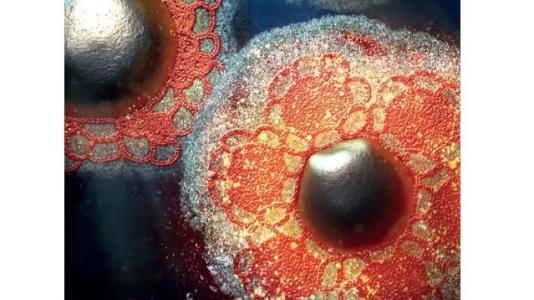
Scientific Achievement
The search for eco-friendly methods to develop electronic materials without toxic organic solvents has led to water-borne core-shell semiconductor nanoparticles (NP) for photovoltaic applications. Water-borne methods do not yet have the ability, however, to control how the core-shell structure develops for optimum performance. This study sought to understand and control how the core-shell structure develops and tune methods for higher efficiency materials. The water-borne NP method uses a surfactant-water phase plus a semiconductor organic phase. In previous work a surfactant-water phase that improved electronic interaction was developed, and in this study the goal was to increase charge separation efficiency, a characteristic that directly affects photovoltaic performance. Several NPs were synthesized and their performance compared. Devices were analyzed using small-angle X-ray scattering (SAXS), dynamic light scattering (DLS), and transmission electron microscopy (TEM). Analysis clearly indicates the dependence of charge separation efficiency on the core-shell structure. Photovoltaic devices with the NPs also were fabricated.
Significance and Impact
Efficiency measurements corroborated the optimum protocol for developing the water-borne NPs. Results showed the important role shell morphology plays in the electrical activity of the device. This work provides a means to synthesize effective water-based organic semiconductors; photovoltaic cells with >5% efficiency were achieved.
Research Details
At the Center for Nanoscale Materials, five groups of NPs were synthesized with varying phases and materials; performance parameters were measured; time-resolved photoluminescence, DLS, TEM, and UV-visible absorption spectroscopy were employed. At the Advanced Photon Source, small-angle X-ray scattering (SAXS) was performed at sector 12 beamline ID-B.
Work was performed at the Center for Nanoscale Materials and the Advanced Photon Source.
About Argonne’s Center for Nanoscale Materials
The Center for Nanoscale Materials is one of the five DOE Nanoscale Science Research Centers, premier national user facilities for interdisciplinary research at the nanoscale supported by the DOE Office of Science. Together the NSRCs comprise a suite of complementary facilities that provide researchers with state-of-the-art capabilities to fabricate, process, characterize and model nanoscale materials, and constitute the largest infrastructure investment of the National Nanotechnology Initiative. The NSRCs are located at DOE’s Argonne, Brookhaven, Lawrence Berkeley, Oak Ridge, Sandia and Los Alamos National Laboratories. For more information about the DOE NSRCs, please visit https://science.osti.gov/User-Facilities/User-Facilities-at-a-Glance.
Argonne National Laboratory seeks solutions to pressing national problems in science and technology. The nation’s first national laboratory, Argonne conducts leading-edge basic and applied scientific research in virtually every scientific discipline. Argonne researchers work closely with researchers from hundreds of companies, universities, and federal, state and municipal agencies to help them solve their specific problems, advance America’s scientific leadership and prepare the nation for a better future. With employees from more than 60 nations, Argonne is managed by UChicago Argonne, LLC for the U.S. Department of Energy’s Office of Science.
The U.S. Department of Energy’s Office of Science is the single largest supporter of basic research in the physical sciences in the United States and is working to address some of the most pressing challenges of our time. For more information, visit https://energy.gov/science.